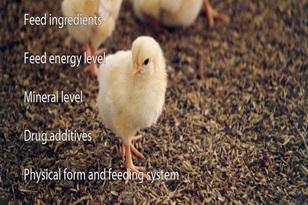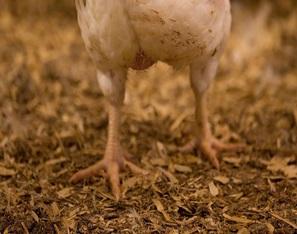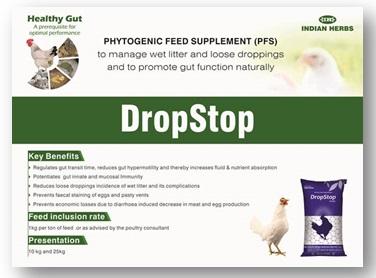Wet Litter menace in poultry houses and management strategies
Published: July 19, 2023
By: Indian Herbs. Contact: Dr. Shivi Many
Watery and sticky droppings in layers have been a problem in the egg industry for years. Wet droppings or diarrhea in chickens are early indicators of intestinal distress and can give a producer crucial information about the general gut health of their flock. Poultry litter becomes wet when the rate of water addition exceeds the rate of removal. Poor quality ingredients, toxins, pathogens and nutrient imbalances can cause wet litter directly by altering normal digestive physiology or indirectly by disturbing normal gut ecology.

In today's intensive production systems even relatively minor nutritionally induced osmoregulatory perturbation can cause flushing. High proportion of non-starch polysaccharides (NSP) increase gut viscosity leading to pasty vent/ loose droppings. High fibre in diet, change in feed, irritant effects of organic acids, chemical toxin binders, feed contaminants, dietary factors, stress due to summer or high production are also responsible for non-specific diarrhoea/loose droppings or may also cause pathological change by inducing a detrimental shift in the composition of the intestinal microbiota (dysbacteriosis) and further complicating into enterotoxigenic / enteroinvasive enteritis. Non-nutrition related problems that also contribute to wet droppings in layers include feed contamination, toxins, excessive drinking, an inappropriate amount of Ca and electrolyte balance in the diet, strain differences in mineral requirements leading to poor fluid resorption. The major loss to the poultry industry is through increased percentage of dirty eggs and systemic diseases.
The underlying causes of wet droppings are frequently complex and multifactorial. Amongst environment factors, high temperature and humidity have a severe influence on the water intake and water output in poultry production. High water intake in heat stress is also contributing to litter every day. Wet litter is a complicated problem brought on by a number of interconnected elements, including bird management, housing, nutrition and gut health. Other factors either alone or combined together (viz. electrolyte imbalance, non-starch polysaccharide meals, and environmental change) induce physiological disturbances in birds leading to stimulated hypothalamus and inhibiting release of anti-diuretic hormone. Birds then drink extra water and produce watery droppings to make up for the loss caused by the high urine output. As a result, the litter gets wet, decreasing the chicken’s ability to produce eggs and leading to the development of foot pad dermatitis (FPD).
It is important to discover the underlying causes of wet droppings at the farm, it serves as a helpful early warning indicator and to frame up management strategies.
Here are strategies to manage wet litter in poultry houses
1) The supply of a balanced, comprehensive diet is of the utmost importance for ration composition and diet control. Wet manure is produced as a result of issues with high-performance genetics, feed composition and medication.
2) Improve the density of the chicken stocking to assist prevent too much moisture in the poultry house.
3) In order to maintain the comfort and atmosphere of the home, temperature adjustments must be done.
4) Boost the digestibility of nutrients. Supplementing right choice of additives is another way to accomplish it.
5) Improve your birds' intestinal health with DropStop by Indian Herbs Specialities. It promotes gut integrity and reduces wet droppings in your birds. It also has anti-inflammatory properties and works towards enhancing gut immunity.

Optimize chicken gut health and prevent wet litter with the power of DropStop
DropStop is a research based unique blend of natural phyto-ingredients that help prevent wet litter/ diarrhoea and to maintain healthy gut function in poultry birds. It prevents malabsorption and helps in reinvigorating dull birds and dehydrated birds along with improving the nutrients availability. It mainly addresses the problem of wet litter in poultry production which results in loss of fluids, pasty vents and staining of eggs. It optimizes the peristalsis and helps in removal of toxins and gases and prevents colonization of pathogens in gut. Supplementing DropStop is intended to restore productivity, hatchability and improve quality meat and eggs.
The synergism of phyto-constituents in DropStop prevent intestinal hypermotility, controls hypersecretions, binds excess fluid in gut, helps regularizing peristalsis, provides anti-inflammatory effect on gut lumen, enhances gut immunity and improves microbiome. Unlike antibiotics it does not exert any damage to friendly microbiota and is Devoid of resistance and residues.

Summary
Our excellence and innovation in phytogenics are proven to support poultry producers and provide competent solutions to achieve poultry welfare, higher production indices and better returns on investment. DropStop is a research oriented science based product to achieve gut health and to beat the odds of diarrhoea and wet litter. DropStop is recommended for control of loose droppings and for complete management of wet litter. Supplementing DropStop as feed supplement helps reduces incidence of wet Litter and its complications such as faecal staining of eggs and pasty vents. Heavy economic losses due to diarrhoea, poor productivity and dirty eggs can surely be averted with the usage of DropStop.
References
To be requested from author
Related topics:
Authors:
Indian Herbs
Recommend
Comment
Share
Recommend
Reply

Would you like to discuss another topic? Create a new post to engage with experts in the community.









.jpg&w=3840&q=75)